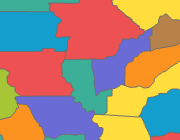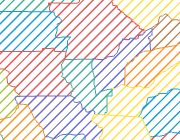Unique values symbolize qualitative categories of values. Examples include habitat types, planning zones, voting preferences, and soil classifications.
Unique value symbology can be based on one or more attribute fields in the dataset, or you can write an Arcade expression to generate values on which to symbolize.
If you have access to a style that has symbols named to match the symbol class values, you can use the Match Layer Symbology To A Style geoprocessing tool to apply unique values symbology to the layer.

The Primary symbology tab  has two subtabs to establish unique values symbology:
has two subtabs to establish unique values symbology:
- The Classes tab is where you manage the symbol, its patch shape, the values, the descriptive labels, and grouping of the symbol classes.
- The Scales tab is where you specify the scale ranges in which each symbol class draws.
To symbolize using unique values, complete the following steps:
- Select a feature layer in the Contents pane. On the Appearance tab, in the Drawing group, click Symbology and click Unique Values to open the Symbology pane.
- In the Symbology pane, on the Primary symbology tab
 , in the Field 1 menu, choose a field on which to symbolize.
, in the Field 1 menu, choose a field on which to symbolize. - Optionally click the expression button
 to open the Expression Builder dialog box. Write an expression and click Verify
to open the Expression Builder dialog box. Write an expression and click Verify  to validate it.
to validate it. - Optionally click Add Field to add additional symbol permutations. You can have up to three symbology fields. Only the first field can use an expression.
- Choose a color scheme.
Depending on the number of unique values, the color schemes from project styles are filtered so that only relevant color schemes are presented to you. For example, if you have only five unique values, you see quantitative color schemes showing five colors. In addition, you can also choose from random color schemes. Check the Show all check box to see all available color schemes. Color schemes stored in your Favorites style or custom styles always appear in this list, regardless of their type or number of colors. Click Format color scheme to modify a scheme.
- Optionally click Add all values
 . When choosing a field for unique values for the first time, no values are added.
. When choosing a field for unique values for the first time, no values are added.
Set the color scheme target
If you are symbolizing polygons, click the Color scheme options button  to choose the target for the color scheme. You can apply the colors to the polygon fills, outlines, or both.
to choose the target for the color scheme. You can apply the colors to the polygon fills, outlines, or both.
When you change the color scheme target, the other symbol layers of the polygons symbolizing each symbol class are not updated. For example, when you set the color scheme target to Apply to outline, the fill symbol layers are not updated, and setting it to Apply to fill does not alter the outlines of the polygons. This is to ensure that customized symbology is not lost. Symbol layers that are color locked are not updated by changes to the color scheme regardless of the color scheme target setting.
To update all symbol layers to match the color scheme target setting, click the More drop-down menu and click Regenerate all symbols.
| Color scheme target | Result | Result after regenerating symbols |
|---|---|---|
| Apply to fill | The color scheme is applied to the fills (fill symbol layers) of the polygon symbols. | The color scheme is applied to the fills of the polygon symbols. Polygon outlines (stroke symbol layers) are solid gray lines. |
| Apply to outline | The color scheme is applied to the outlines (stroke symbol layers) of the polygon symbols. | The color scheme is applied to the outlines of the polygons. Polygon fills are fully transparent. |
| Apply to fill and outline | The color scheme is applied to the fills and outlines (fill symbol layers and stroke symbol layers) of the polygon symbols. | The color scheme is applied to the outlines of the polygons. The color scheme is applied to the fills of the polygons as hatches. |
Modify unique value symbology
You make most changes to unique value symbology from the Label view  . You can modify unique value symbology as follows:
. You can modify unique value symbology as follows:
- To edit symbols, click a symbol in the Symbol column of the table to open the Format Symbol pane to modify the symbol or choose a different symbol.
- For line and polygon features, click the drop-down arrow next to the symbol to set the symbol's legend patch. To change multiple patches at the same time, hold Shift+click or Ctrl+click to select the symbols, right-click the selection, and select Update legend patch to choose the patch shape.
- To edit the symbol class label, click the label in the Label column and type a new label.
- To change the order of the symbol classes, drag a symbol class row to a new position in the table or click Move selected value(s) up
 or Move selected value(s) down
or Move selected value(s) down  . To sort values, right-click the Value or Label heading and click Sort Ascending
. To sort values, right-click the Value or Label heading and click Sort Ascending  or Sort Descending
or Sort Descending  . The symbol class order is reflected in the Contents pane and also in legends on layouts.
. The symbol class order is reflected in the Contents pane and also in legends on layouts. - To remove a symbol class, right-click the symbol class and click Remove
 . No data is deleted, but the associated features do not draw. Note that they may still be symbolized by an All other values group at the bottom of the table that collectively draws all values that are not otherwise symbolized by a symbol class.
. No data is deleted, but the associated features do not draw. Note that they may still be symbolized by an All other values group at the bottom of the table that collectively draws all values that are not otherwise symbolized by a symbol class. - To remove the All other values collective group so that only features participating in symbol classes are drawn, right-click the symbol class and click Remove
 , or click More and uncheck Show all other values.
, or click More and uncheck Show all other values. - To add additional symbol classes, click Add unlisted values
 to open a table in the Select values to add subpane. This table lists all values not currently symbolized. Click Options and click Add new value
to open a table in the Select values to add subpane. This table lists all values not currently symbolized. Click Options and click Add new value  to type a new value.
to type a new value. - To combine symbol classes, select the symbol class rows from the table while pressing the Ctrl key. Right-click and click Group values
 to combine selected classes into one group.
Ungroup a grouped class by right-clicking it and clicking Ungroup values
to combine selected classes into one group.
Ungroup a grouped class by right-clicking it and clicking Ungroup values  .
. - To organize symbol classes into headings, right-click a symbol class. Under Move value, choose Existing group and click the group's name. Click New group to create a new heading. To change the name, click the heading title <heading>. Headings are reflected in the Contents pane and also in legends on layouts.
- To reset each symbol class to its default symbol based on current symbology parameters, click the More drop-down menu and click Regenerate all symbols. You may want to do this after you've changed the color scheme target, or to discard individual symbol edits and get back to a default state.
- To set up masking per feature, click the Advanced symbology options tab
 and expand Feature level masking.
and expand Feature level masking.
Vary unique value symbology by transparency, rotation, size, or color
In addition to specifying qualitative symbology with unique values, you can also symbolize additional attributes by varying the transparency, rotation, size, and color of the unique value symbols. While all of these treatments can be applied simultaneously, be aware that too many visual variations make the layer difficult to interpret. It is advisable to apply secondary symbology sparingly.
Learn more about symbolization concepts
- In the Symbology pane, click the Vary symbology by attribute tab
 .
. - Expand Transparency, Rotation, Color, or Size. With polygon features, Outline width replaces Size, and Rotation is not available.


